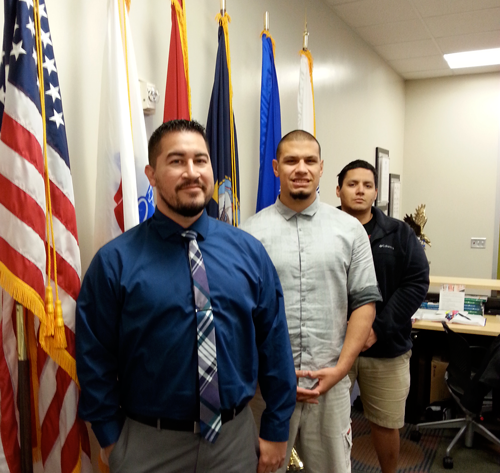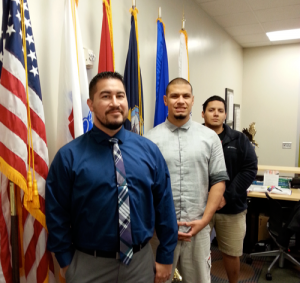
Veterans cope with ‘invisibility’ on campus

Marine veteran Mike Medina remembers the isolation he felt when he enrolled in Texas City’s College of the Mainland in the spring of 2011.
“Yeah, definitely,” said Medina, 27, who did a tour as a sergeant in Iraq as a helicopter mechanic and is currently a UHCL graduate student pursuing a degree in criminology. “I couldn’t talk to anybody.”
With wars in Iraq and Afghanistan over and enhancements to the Montgomery GI Bill 30, Vocational Rehabilitation Bill 31, Post-911 Bill 33 and Texas’ Hazlewood Act, colleges and universities have experienced a surge in veteran enrollment unseen since the Vietnam War. A significant number of veterans face a difficult transition to civilian and academic life, ranging from readjustment issues to recovery from physical injuries and post-traumatic stress disorder (PTSD). Maureen Dyman, communications director for the Michael E. Debakey Veterans Administration, believes that this difficulty is, at least initially, the norm for returning veterans.
“We have a lot of returning veterans enrolled in colleges and universities right here in Houston,” Dyman said. “Serving in Iraq and Afghanistan is a huge life experience, and there are readjustment issues. Sometimes it’s physical, with back problems or missing limbs, and sometimes it’s mental issues, as with PTSD. That’s just part of the territory. It goes with the job.”
Indiana University’s National Survey of Student Engagement Institute conducted a survey that interviewed nearly 11,000 student veterans in 2010 who were first-year students or seniors at four-year schools. The veterans reported interacting less with their instructors than did classmates who had not enlisted. They were less likely to partake in educational opportunities such as internships or study abroad.
Marine veteran Chris Ramirez had trouble getting back into student mode after returning from a tour in Afghanistan in 2011. He is currently working on a master’s degree in physics at UHCL. The initial transition proved difficult, having sustained back and knee injuries during the war. PTSD was a common problem for Ramirez and his fellow soldiers.
“It’s pretty much the same for everybody over there with PTSD; the lucky ones found jobs in places like oil fields, where they worked in small groups, like the way we worked over there,” said Ramirez, referring to the tightness of small field squads in Afghanistan. “I initially had trouble working with people, developing trust with others. It took most of the semester to settle in.”
Ramirez encountered a fellow classmate who served in Afghanistan. Ramirez said it helped with the transition, but the two veterans were not able to spend any off-campus time together because his new friend was married with kids.
“I had to work mainly by myself,” Ramirez said. “When I got stressed, it was hard to focus on stuff. It was frustrating. You try to be invisible.”
Jay Hernandez, certifying official at UHCL’s Capt. Wendell M. Wilson Office of Veteran Support Services, also known as “VSO,” did two tours in Iraq and one in Afghanistan as an Army Intelligence Analyst Staff Sergeant. Discharged in the fall of 2011 after 12 years in the military, he enrolled at UHCL as an undergraduate seeking a degree in geology in the spring of 2012.
Told of Ramirez’s desire to be invisible, Hernandez agreed that this was a common mindset for returning veterans.
“Definitely,” Hernandez said. “I can see it in others, especially the ones that did a long stint. They’re unsure. When veterans get back in civilian life, a lot of people don’t understand their situation, and vets choose not to talk about it. They’ve been groomed to not stand out, to instead be part of a team. Invisibility, in that aspect, is what it’s about. You don’t want to be noticed.”
Hernandez said that the primary duty of the VSO is military benefits.
“It would be an injustice to not go the extra mile, though,” Hernandez said, referring to assisting transitioning veterans.
One way the VSO goes the extra mile is by providing counseling services every Monday from 10 a.m. to noon.
VSO counseling services involve basic functions such as help with resumes, employment search assistance and interview preparation, but it also provides help for veterans facing issues of anxiety, insomnia, concentration and memory lapse.
Hernandez admits the initial transition to civilian and academic life was difficult for him.
“My whole life was the military, from the age of 18 on,” Hernandez said. “The most difficult thing was the identity crisis of learning who I was after military life ended … learning who Jay Hernandez was.”
Dyman agrees that discovering one’s post-military identity is crucial toward transitioning to life in “the real world.”
“We have recognized that veterans returning from Iraq or Afghanistan face challenges with the adjustment to civilian life, especially when returning to academic life,” Dyman said. “The Veterans Administration has a ‘peer support’ program that incorporates veterans as counselors who can assist returning veterans with issues they themselves have faced and dealt with.”
Dyman also said that the Lone Star Vets Association is an excellent organization that can aid returning soldiers with their transition to civilian life.
“That way,” Dyman said, “they’ll know they’re not alone in the world.”
Click here to view The Signal reporter Samantha Oser’s interactive storymap of veteran memorials in the Houston area.

Thank you, Liz, for an exceptional job at editing something rough and making it perfect.